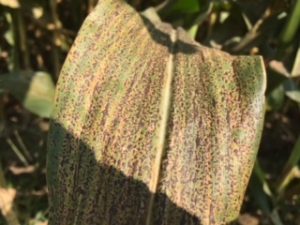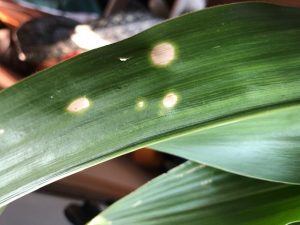Most of Illinois this season has been hot and dry, especially through central and northern portions of the state . This has been good as far as limiting foliar diseases in our corn crop. Fungi require some level of moisture for spores to germinate, and the fungus to grow and infect foliage. This is a major reason why we have less foliar disease in dry seasons vs wet seasons (earth shattering information, I know!).
The rains that have moved through the state the past week, though needed by our crop, also likely will cause foliar diseases to start to increase. Recently we have seen reports of the following in parts of the state:
1) Grey leaf spot. This one is our biggest issue across seasons. It likes it warm and really wet. Lesions start out as small flecks that expand to matchstick lesions on leaves and blotchy lesions on stalks. Ends are squared and lesions often delimited by veins.
2) Tar spot. This one likes it moderate and wet/muggy. Starts as chlorotic specks that develop into small circular to angular, often raised growths scattered on leaves, sheaths, and husks. They cannot be washed or scraped off of leaves, unlike insect frass. They are not found in bands or strips like Physoderma. I expect that if you look hard enough you will find a spot or two (literally) in Northern Illinois, especially if you are following no till corn that had tar spot last year. I also think that it shows up around this time each year we have had it since 2015. The difference is that now people are looking for it and can recognize it, as opposed to ignoring it or missing it. Therefore, I would not be too riled up about reports of it on a plant or two in surrounding states right now. Just make sure you are getting out into your fields and scouting. As I said last year, AVOID THE COSMIC FREAKOUT. With the rains that moved through, it wouldn’t surprise me if you start seeing more tar spot in about 2-3 weeks (around the week of July 26th), depending on hybrid and local environmental conditions. If you start to encounter stroma frequently in a field and and you are near VT-R3, you might want to consider a premix fungicide if you are frequently encountering stroma in the field. We saw good residual control from residue borne tar spot last season (click here for 2019 applied research book, results, and more information). A single well timed application can work well for this one. As I said over the last two years, don’t be that person who calls in a sprayer over bug feces. As usual, if you see something, send me a note (@ILplantdoc, nathank@illinois.edu, phone).
3. Northern corn leaf blight. This one is another one that likes it moderate and wet. Look for long, cigar shaped lesions with a gray/green center. If you have a microscope, the spores look like the bratwurst you ate over the July 4th holiday. If this one flares up on a susceptible hybrid, look out! Check out the trial from Carmi Illinois in the 2019 Applied Research Book (link above) for some data showing fungicide performance in a “perfect” situation (susceptible hybrid, disease present near ear leaf at very low levels at VT, fungicide applied at disease onset, and wet weather+irrigation).
4. Southern Rust. In the southern parts of the state this one can be scary. Small, orange to light brown pustules mostly on the upper leaf surface and occasionally stalks. It is picking up a tick in Arkansas, but weather patterns and conditions luckily are not likely to push things into the state. When southern rust blows in before R3 and conditions are conducive, you can see some major damage. The Carmi trial mentioned above also had a lot of Southern rust. Most hybrids are very susceptible, so again, scout!
You’ll also see some Diplodia leaf streak in the Southeast (blocky lesions with dark centers) and a smattering of common rust (brick red pustules on upper and lower leaf surfaces) in the state. Now is also the time to start seeing foliar symptoms of Physoderma popping up, which is very likely given the wet start to the season. No need to spray for any of these.
Research has shown that producers have the best chance to make a return on the investment of an application when fungicides are applied between that VT-R2 window. Yes there are occasions where maybe waiting a little later might pay, as well as two pass programs, but the data since the 2010’s still say that VT-R2 window is the sweet spot. More applications mean you need to recover larger yield reductions, and waiting until R4/5 to spray isn’t likely to result in much benefit, as most of the yield has been made at that point. Standability? If you have severe disease pressure, fungicides certainly can help in that regard. Little to no disease? Don’t expect a consistent benefit.
The take home message: given the status of the crop and recent storms, we need to step up our scouting efforts. Check fields every 7-10 days through R3, or longer depending on your abilities.


